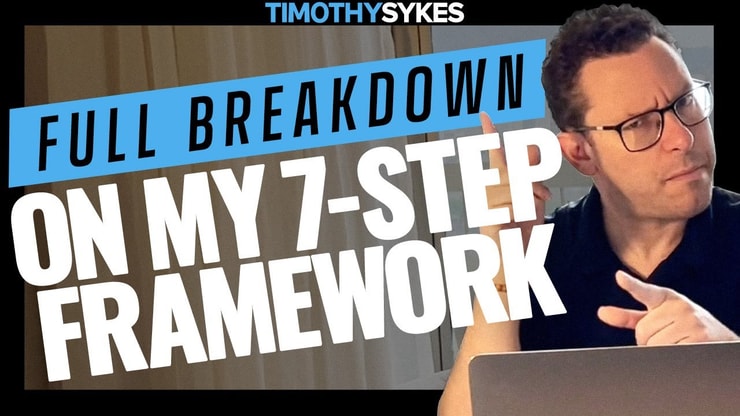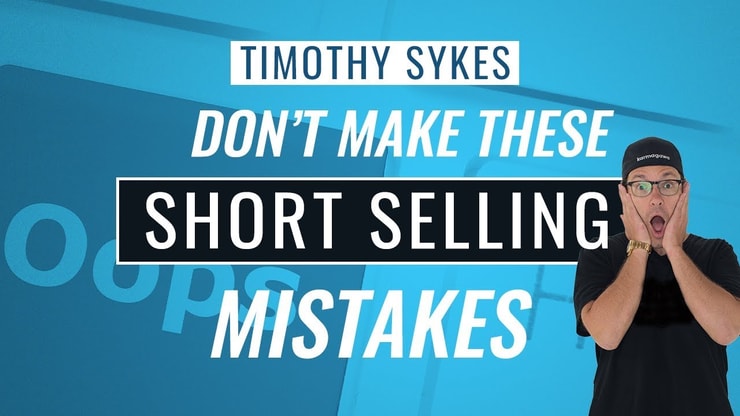The Ascending Wedge is a bearish pattern. Traders can use this pattern to make money shorting stocks.
I teach new students to spend a lot of time studying patterns.
Why?
Chart patterns tend to repeat. It’s not an exact science, but it will often give you a clue about the stock’s future price action.
I don’t advise new traders to start as short sellers. A shorted stock could spike infinitely higher — which means the losses are unlimited.
Even if you don’t plan on short selling, learning a pattern like this will help paint a clearer picture of the market. And a higher understanding leads to higher security as a trader.
Whether you’re a short seller or a long-biased, keep reading for an essential market pattern!
Table of Contents
- 1 What is an Ascending Wedge?
- 2 All to Know About the Ascending Wedge Pattern
- 3 Trading Strategies with Ascending Wedge
- 4 Managing Risks in Ascending Wedge Trading
- 5 Pros and Cons of the Ascending Wedge
- 6 Key Takeaways
- 7 FAQs
- 7.1 Where Does the Falling Wedge Occur?
- 7.2 Are Wedges in Forex Profitable?
- 7.3 What is the Expected Outcome of a Rising Wedge Breakdown?
- 7.4 Can You Explain Some of The Common Patterns In Trading?
- 7.5 Who Are the Main Players in the Stock Market?
- 7.6 What Are Some Strategies for Trading in the Stock Market?
- 7.7 Where Can I Learn More About Trading in the Stock Market?
What is an Ascending Wedge?

2025 Millionaire Media, LLCThe Ascending Wedge is a crucial pattern for traders interested in technical analysis. It’s formed when price action narrows as prices climb higher, creating a wedge.
It’s recognized by two trend lines — the support line below and the resistance line above. Both slope up but at different angles. The resistance line above is more horizontal or flat, which gives it a wedge shape.
The ascending wedge is a versatile pattern, but it’s not the only one you should have in your toolkit …
For all my long-biased traders, the bull flag pattern is a reliable indicator of bullish momentum. They’re straightforward to spot and can help you make strategic trades.
Ready to broaden your understanding of price chart patterns? Explore this detailed breakdown of bull flag patterns.
Characteristics of an Ascending Wedge
An Ascending Wedge is marked by higher highs and higher lows.
It’s a consolidation phase between two levels. The diagonal lines indicate a momentary pause in trend direction — that’s a signal for traders to watch.
The volume often decreases as the pattern forms, reflecting the slowing pace of the uptrend.
What is an Ascending Wedge Chart Pattern?
An Ascending Wedge chart pattern is a bearish indicator typically found at the end of a bullish trend.
It signals a possible trend reversal, where the bullish behavior might decline, offering a potential entry point for bearish traders.
All to Know About the Ascending Wedge Pattern

2025 Millionaire Media, LLCThe Ascending Wedge Pattern, a phenomenon of technical analysis, is a bearish signal often observed after an uptrend.
The formation of higher highs and higher lows within converging trendlines forms a wedge with a positive slope. It signals market consolidation and a potential slowdown in the upward price movement.
The confirmation comes with a breakdown through lower support. It’s typically accompanied by increased volume, providing a hint of the upcoming market direction.
Understanding the ascending wedge is crucial, but it’s just one piece of the puzzle.
Remember what I said about painting a clear picture …
The cup and handle is a related pattern that can signal a bullish trend. It’s a unique formation that can lead to a significant amount of gains if you know how to spot it.
Want to expand your pattern recognition skills? Dive into this comprehensive guide on the cup and handle.
More Breaking News
- Cleveland-Cliffs Shares Gain Momentum as New Growth Initiatives Unveiled
- Verona Pharma’s Stock Poised for Gains After Positive Analyst Coverage
- Ondas Strengthens U.S. Drone Manufacturing Through New Partnerships
Identifying a Rising Wedge Pattern
To identify a rising wedge pattern, we need to spot the two upward-sloping trendlines.
As the wedge forms, the distance between the support and resistance lines decreases (the figure slopes toward a point). The price movement within this narrowing range will indicate the market’s future direction.
Why Ascending Wedge Forms
Like all stock patterns, the price chart follows human emotion.
And since humans always react the same during periods of high stress/greed, these patterns will likely never change.
I mapped out the main movement over two decades ago and we still see it happen today. It’s called the 7-step framework. I included a video below …
In the case of an ascending wedge, it forms due to a tussle between buyers and sellers in the market.
While both drive prices up, buyers lose momentum over time. This leads to the uptrend’s slowing pace and the wedge’s formation.
Rising Wedge Pattern Confirmation
The rising wedge pattern confirmation occurs with a breakdown — a candlestick with a decisive close below the support line.
This trendline break is often accompanied by an increase in volume. It enhances the bearish signal’s reliability several times over.
The Difference between Rising Wedge vs. Ascending Triangle
While both are chart patterns, they differ in their implications.
A rising wedge is bearish, indicating a potential price decline. But an ascending triangle can be either bullish or bearish. It depends on the breakout’s direction.
How Reliable Are Rising Wedges?
Rising wedges are considered reliable reversal patterns, particularly when observed in an uptrend and confirmed by a breakdown with a volume increase.
However, like all indicators in technical analysis, they should be used alongside other tools for best results.
As traders, it’s our job to protect the overall account. The more indicators we use to confirm a trade, the less risk to our account.
Trading Strategies with Ascending Wedge

2025 Millionaire Media, LLCWhen trading with an Ascending Wedge, patience is the key.
Once you identify the pattern on the chart, the real game begins with the breakout …
A decisive close below the support line indicates a bearish breakout.
At this point, traders can initiate a short position with a stop loss just above the recent high. A stop loss will help short sellers limit their risk in case we see a price rally.
Trade setups are never a 100% guarantee. That’s why we use key patterns. The chart’s recent high is the risk level, and as for potential profits …
The height of the wedge can serve as a target for the expected price drop. Short sellers would then ideally buy back shares at the end of the drop and cash out for a sweet return.
Let me remind you, short selling is a risky strategy for beginners. If you want to trade this pattern, make sure you’re not making any of these mistakes …
While the ascending wedge is a powerful tool, it’s not the only pattern that can help you make informed trades.
The diamond pattern is another price chart formation that traders use to predict future price movements. There are some key differences, but once you understand it, it can be a game-changer.
Ready to step up your trading game? Check out this deep dive into diamond pattern trading.
How to Trade an Ascending Wedge?
Trading an ascending wedge involves waiting for a breakdown for entry, that’s the continuation signal. Once the price falls below the support line, it’s an indication the price could move lower.
That’s when traders may enter a short position, setting a stop loss above the breakout point and a target based on the wedge’s height.
How to Trade an Ascending Triangle?
Trading an ascending triangle is different as it’s a continuation pattern. :
Traders wait for the price to break the resistance line before entering a long position. A stop loss is placed just below the breakout point, and the target is calculated using the triangle’s widest distance.
Managing Risks in Ascending Wedge Trading

2025 Millionaire Media, LLCRisk management in Ascending Wedge trading is of utmost importance. Defining a clear stop-loss strategy is essential.
The stop loss could be set just above the recent high, it closes the trade if the price moves against the anticipated direction.
It’s vital to remember that the success of the strategy heavily depends on accurate pattern identification, a well-defined exit strategy, and disciplined execution.
Ascending Wedge Stop Loss Strategies
Stop-loss strategies are essential in managing risks. For ascending wedges, the stop loss can be placed just above the breakout point. If the price rebounds past the wedge, the position is closed, limiting potential losses.
Pros and Cons of the Ascending Wedge
The Ascending Wedge comes with several pros and cons.
On the plus side, it is relatively easy to spot and offers clear trade signals. Its bearish reversal signal can lead to profitable trades when correctly interpreted.
However, the pattern has its cons. Its dependence on a breakout for confirmation might lead to late entries. Furthermore, the presence of false breakouts can lead to potential losses.
This highlights the need for a sound risk management strategy and the use of additional technical indicators.
Pros
The Ascending Wedge …
- Provides clear signals for entry, stop, and target, making it a straightforward pattern for traders.
- It’s considered reliable for indicating bearish reversals.
- It can be spotted across different markets — stocks, futures, forex, or crypto.
Cons
The main disadvantage is …
- Its reliance on a breakout for confirmation could lead to late entries. Moreover, false breakouts can result in losses. So it’s advisable to use the pattern alongside other indicators for confirmation.
Key Takeaways

2025 Millionaire Media, LLCThe Ascending Wedge is a bearish reversal pattern offering clear trading signals. Its reliability is enhanced when used with volume analysis and other technical tools.
It’s important to manage risks with stop-loss strategies, considering both profits and potential losses.
It isn’t a silver bullet for your trading plan — but the ascending wedge pattern is one of many topics you should learn as part of your trading education!
Trading isn’t rocket science. It’s a skill you build and work on like any other. Trading has changed my life, and I think this way of life should be open to more people…
I’ve built my Trading Challenge to pass on the things I had to learn for myself. It’s the kind of community that I wish I had when I was starting out.
We don’t accept everyone. If you’re up for the challenge — I want to hear from you.
Apply to the Trading Challenge here.
Trading is a battlefield. The more knowledge you have, the better prepared you’ll be.
Do you use support and resistance levels in your trading strategy? Let me know in the comments — I love hearing from my readers!
FAQs
Where Does the Falling Wedge Occur?
The Falling Wedge, contrary to the Ascending Wedge, typically occurs in downtrends, signaling a possible bullish reversal.
Are Wedges in Forex Profitable?
Wedges can be profitable in forex trading, but their effectiveness depends on proper identification, confirmation with other indicators, and sound risk management.
What is the Expected Outcome of a Rising Wedge Breakdown?
The expected outcome of a rising wedge breakdown is a bearish trend reversal, where prices decline following a breakout below the support line.
Can You Explain Some of The Common Patterns In Trading?
In trading, several patterns indicate potential price movements. Candlestick charts often display these patterns.
For example, wedge patterns and triangles are continuation patterns, suggesting the price trend will continue in its existing direction.
Similarly, a trading range indicates the price is moving between a high point, known as the resistance level, and a low point or support level.
Recognizing these patterns can help traders anticipate potential market movements.
Who Are the Main Players in the Stock Market?
Several key players contribute to the dynamics of the stock market.
- Traders and investors are people buying stocks with the expectation of earning a profit.
- Brokers facilitate the buying and selling of stocks, often on behalf of traders and investors.
- Analysts provide research and predictions about stock performance.
- Buyers and sellers are individuals or entities looking to trade a stock.
What Are Some Strategies for Trading in the Stock Market?
There are multiple strategies for trading in the stock market. Some traders use contracts or options, which give them the right to buy or sell a stock at a specific price.
Stop-loss orders are a strategy to limit potential losses, where a stock is sold when it reaches a certain price. Always remember to protect the account.
Understanding market trends, such as rallies (rising prices) and bear markets (falling prices), can also guide trade decisions.
Where Can I Learn More About Trading in the Stock Market?
There are many resources available for learning about stock trading. Beginners benefit a lot from a structured course that covers the basics, different types of trades, and trading strategies.
In addition to courses, articles and reviews on trading websites can provide valuable information and advice. But always ensure the content is from a reliable source.
This industry is full of shady characters ready to scam innocent people out of money.
That’s why my team and I closely monitor the Challenge chatroom.
We’ve had to boot a few promoters before and we’re not afraid to do it again.
If you’re just an average Joe or Jane, and you’re looking for hot market opportunities, come learn from real professionals in the industry.











Leave a reply